GROWING FIGS IN COLD CLIMATES video recording now available.
/0 Comments/in Fruit, Planning/by Lee ReichWatch, listen, and learn — on your own time — about GROWING FIGS IN COLD CLIMATES, with a recording of a webinar with Lee Reich. Now available online.
Learn about the nice quirks of figs, subtropical plants native to hot, dry climates, that make it possible to grow and harvest fruit from them even in cold climates. With that covered, I detail some practical applications of this information. Winter care, pruning, varieties, and speeding up ripening will all be covered. If you already grow figs, this webinar will help you grow more or better figs, and be able to manage them more easily. If you haven’t yet experienced the rewards of growing figs, you have a treat in store.
To access this video, go to www.leereich.com/video



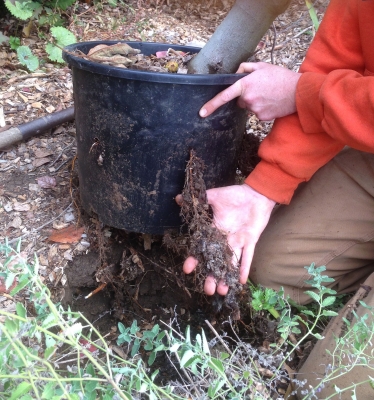
TWO DISAPPOINTING FAILURES, TWO DELICIOUS SUCCESSES
/28 Comments/in Fruit, Gardening/by Lee ReichHelp!!
As flaming red petals drop to the ground beneath my pomegranate bush, I’m not hopeful. Sure, the flowers are beautiful, but the plant is here to give me fruit.
To survive winters here in New York’s mid-Hudson Valley (Zone 5), my plant’s home is in a large flowerpot which I cart into cold storage in late December and back outdoors or into the greenhouse in late winter or early spring. Even my cold-hardy variety, Salatavski, from western Asia, would die to ground level if planted outdoors. The roots would survive that much cold because of moderated below ground temperatures, but new stems that would rise from ground level would need to be more than a year old before flowering.
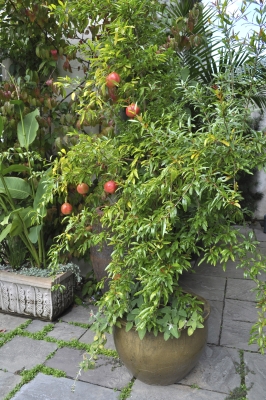
Potted pomegranate, but NOT mine
Growing in a pot, my pomegranate (and other potted fruit plants) need regular pruning and repotting. To prune the pomegranate, I snip off young suckers growing from ground level, shorten lanky stems, and thin out stems where congested. I repot the plant every 2 or 3 years, cutting off roots and potting soil from around the root ball to make room for new potting soil.
When flowers do appear, which they do over the course of a few weeks, I dab their faces with an artists’ brush. Going from flower to flower spreads the pollen from male flowers to the female parts (stigmas) of the hermaphroditic flowers.
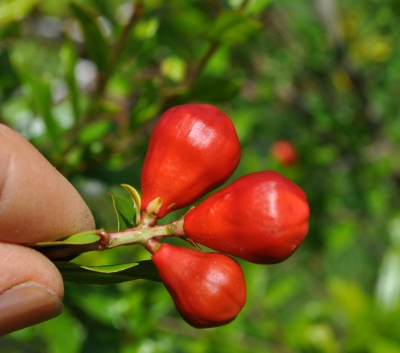
Male pomegranate flowers
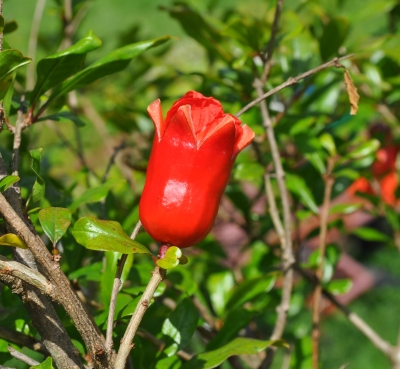
Hermaphroditic pomegranate flower
Then I wait, my eyes concentrating on each flower and hoping to see the base swelling. Problem is most, some year all, the flowers open and then drop. Occasionally, in past years, a flower or two has swelled into a mini-pomegranate. Then also dropped.
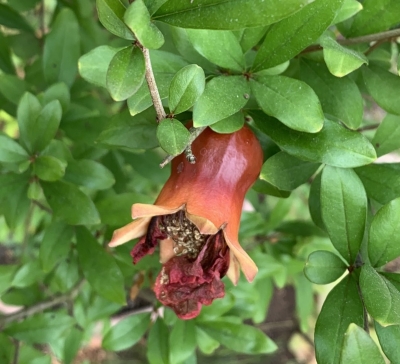
Swelling pomegranate fruitlet
I’ve ministered to this plant for years and it has never rewarded me with a single fruit. Help! Any suggestions?
Not So Idle Threats
Every summer, as my pomegranate drops its last flowers, I’ve threatened it with the same fate I wrought upon another of my subtropical fruit plants, pineapple guava. Beneath the thin, green skin of this torpedo-shaped fruit lies a gelatinous center with a minty pineapple flavor.
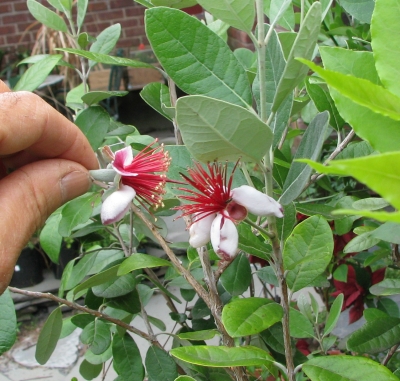
Pollinating pineapple guava
Over the course of growing this fruit for many years, I did harvest a few, small fruits from this plant, but not enough to keep me from reincarnating it as compost. (The flowers, however, reliably produced, sport the most delicious, fleshy petals of any that I’ve taste, with a strong, sweet minty flavor.)
A Most Delicious Fruit
Not all has been failure with my growing subtropical fruits.
My most recent success has been with Pakistani mulberry, Morus macroura, native to Tibet, the Himalayas, and mountainous regions of Indochina. I first tasted this fruit a few years ago at a nursery in Washington State and was swept away by the delicious flavor, sweet with enough tartness to make it interesting, and a strong berry undertone. (Yes, mulberry does have “berry” in its name, but botanically, it’s not a berry; it’s a “multiple fruit.”)
Besides having great flavor, Pakistani fruit is also notable for its enormous size, each one elongating, when ripe, to between three and five inches!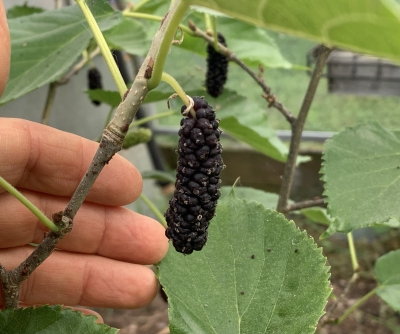
Pakistani mulberry is easy to grow and needs no particular coaxing to bear plenty of fruit, which it does over the course of a few weeks. Mine grows in a pot measuring a little over a foot wide, with the tree rising about four feet high. Fruits are borne on new shoots that grow off older stems, which keeps the tree very manageable. Shortening those older stems each year makes it easier to muscle the plant through doorways to move it indoors for winter and then back outdoors when weather warms a little.
Very Easy, Very Successful, Very Delicious
My longest term and greatest success with subtropical plants has been, of course, with figs. (I write “of course” because I’ve written a whole book whose content is described by its title, Growing Figs in Cold Climates, and now is available as a video of a webinar I have presented on that topic.)
Like mulberries, to which they are related, figs — most varieties — can bear fruit on new shoots that grow off older branches. 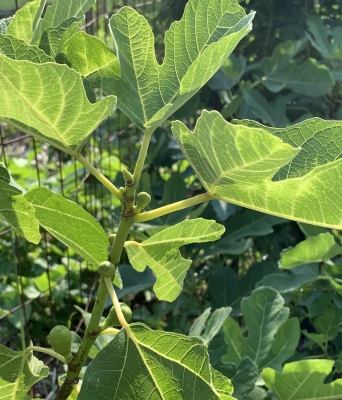 So, like mulberry, the plants can be pruned back some so they’re more manageable to be protected from bitter winter cold. An in-ground plant, then, could be protected from bitter winter cold by being swaddled upright or lowered to the ground, even trained to grow along the ground; a potted plant is more easily maneuvered into a garage, unheated basement, or other cool location for its winter rest.
So, like mulberry, the plants can be pruned back some so they’re more manageable to be protected from bitter winter cold. An in-ground plant, then, could be protected from bitter winter cold by being swaddled upright or lowered to the ground, even trained to grow along the ground; a potted plant is more easily maneuvered into a garage, unheated basement, or other cool location for its winter rest.
Right now, there’s nothing for me to do with my figs except watch them grow. Small figlets now sit in the plants’ leaf nodes. They’ll just sit there, doing nothing, for a seemingly long time. Once ripening time draws near, the figs suddenly puff up, becoming soft and juicy and developing a honey sweet, rich flavor.
RAISING BASIL(S)
/9 Comments/in Gardening/by Lee ReichContinuing Education
“No occupation is so delightful to me as the culture of the earth, & no culture comparable to that of the garden. Such a variety of subjects, some one always coming to perfection, the failure of one thing repaired by the success of another, & instead of one harvest a continued one thro’ the year. Under a total want of demand except for our family table I am still devoted to the garden. But tho’ an old man, I am but a young gardener.”
That’s what Thomas Jefferson wrote to Charles Willson Peal on August 20, 1811. Mr. Jefferson had it right. One thing, among many other, that makes gardening so rewarding for me is that there’s always something new to learn about plants and their cultivation. 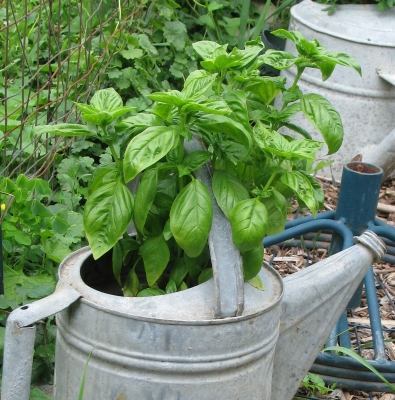
Take basil, for instance, which I, like many of you, have grown for many years. I’ve always been satisfied with a good harvest, enough for adding pizazz to summer salads and for preserving — dried, or frozen as pesto — for winter. But basil growing became more involved some years ago after a seed company sent me sample packets of a few varieties of basil, and then I spoke with some commercial herb growers.
The Lineup
In spring, I planted short rows of all the varieties I had, with a plastic tag at the head of each row. The tags were unnecessary, for no two varieties looked alike and I could have deduced the variety names by the catalogue descriptions. 
Flavor has always been my reason for growing basil, and I wondered just how different each variety would taste from its neighbor one row over. So I picked leaves of each variety and nibbled them. I rubbed their leaves between my palms, then inhaled deeply their aromas. I invited visitors to sample each variety, and as they sampled I badgered them with questions and jotted down notes. A pasta dinner was needed so we could evaluate each type of basil made into a pesto sauce. What torture!
There actually were differences in taste between the basils. The variety called Sweet lived up to its name with a mild flavor. The similarly mild flavor of Napolitano had the slightest hint of licorice; that of Spicy Globe, the slightest suggestion of mint. Progressively stronger in flavor were Lettuce Leaf, then Fino Verde. The taste of Genova was strong, bordering on acrid. Syracusa was one of the best — strongly aromatic, yet smooth to the palate.
I also grew some of the newer varieties resistant to downy mildew disease. Basil downy mildew is a relatively newcomer here, making itself seen by causing a slight yellowing of the leaves, with purple fungal spores on leaf undersides.
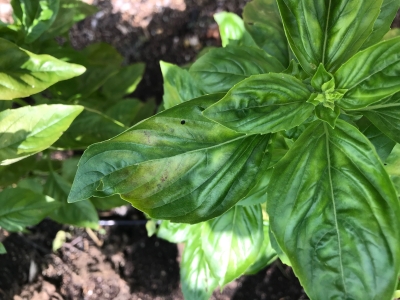
Basil downy mildew, top of leaf
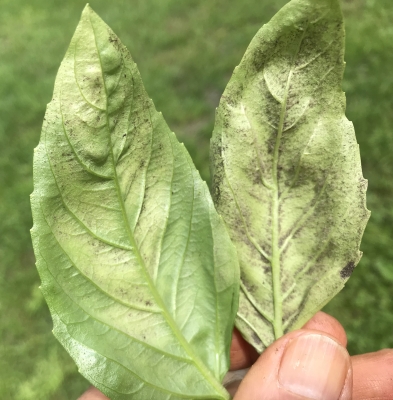
Basil downy mildew, leaf underside
I’ve got little more to say about those varieties because none of their flavors were notably better or as good as the non-resistant varieties, because the disease rarely shows up here, and because it can be controlled with abundant sunlight and good air circulation, and by avoiding infected plants, leaves, or seeds. What’s more, disease resistance is a matter of degree, and various degrees might also exist among the varieties not bred as such.
So, Which to Grow
Honestly, though, the differences in flavor among the tasty varieties were not dramatic; rather, they were subtle nuances of the familiar basil flavor. And tasting a few varieties does put objectivity on shaky ground. Maybe even the order of tasting is important.
So which is the best variety of basil? This brings us back to the striking difference in appearance between the varieties. Since the differences in taste were not that great, I usually choose a basil variety on the basis of plant size, and the size, color, shape, and texture of its leaves. If I want a basil with a very large leaf — perhaps large enough to wrap around a piece of fish to bake — I’ll grow Mammoth.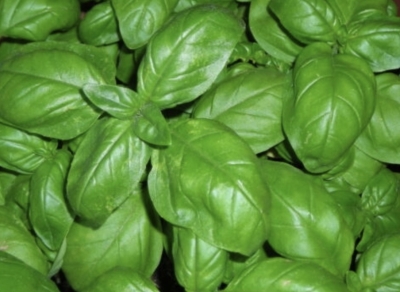
For drying or pesto, I like a variety with a lot of leaf and a minimum of stem. (The dried stems are useless; they’re basil-flavored twigs.) So any variety except small-leaved Fino Verde or Spicy Globe would be suitable for pesto.
For eating fresh in salads, even the small-leaved varieties are okay, since the fresh, young stems are tender. One of the purple-leaved varieties could be used fresh to add a splash of color in salads.
I might grow some basils just for decoration, even if they had no culinary use. Spicy Globe basil, planted close together, makes soft, green mounds resembling a miniature boxwood hedge — a nice border for a terrace or a flower garden. The deep purple color of Dark Opal would contrast nicely with bright yellow and orange zinnias in a sunny flower border. Purple Ruffles could be used for a more frilly effect. The large-leaved, green basils make an island of lime-green if massed together, with a texture dictated by the leaves of the variety chosen: smooth and shiny, wrinkled, or ruffled.
And who knows, maybe I’ll grow certain basil varieties just for the musical sounds of their names. When someone innocently asks, “What kind of basil is that?” I might gesticulate and sing, “Genova Profumatissima,” “Syracusa,” or “Fino Verde Compatto.”

